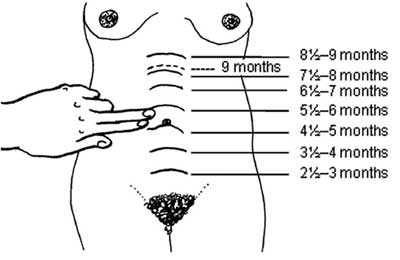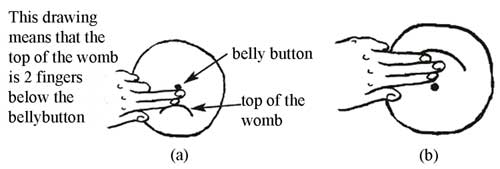10.2.1 How to measure fundal height using the finger method
If the top of the uterus is below the bellybutton, measure how many fingers below the bellybutton it is. If the top of the uterus is above the bellybutton, measure how many fingers above the bellybutton it is.

Look carefully at Figure 10.2. If the baby is growing normally, by how many finger-widths should the uterus rise in the second trimester (3-6 months of pregnancy, or 15-27 completed weeks of gestation)?
 Figure 10.3 Fundal height at 7 months’ gestation.
Figure 10.3 Fundal height at 7 months’ gestation.Fundal height should increase by 6 finger-widths (two finger-widths every month) in the second trimester.
How many fingers above the bellybutton should the top of the uterus be at 7 months’ gestation?
See Figure 10.3 for the answer.
How do you explain the position of the dotted line at 9 months in Figure 10.2, which is below the line showing fundal height at 8½ to 9 months?
Babies may drop lower in the weeks just before birth (look back at Box 10.1).
Look at the diagrams in Figure 10.4 (a) and (b). How many weeks pregnant is the woman in each case, based on the finger method of measuring fundal height shown in Figure 10.2?
In Figure 10.4(a) the woman is about 4½ months pregnant. In Figure 10.4 (b) she is about 6½ months pregnant (three fingers above the bellybutton).
When you measure fundal height at every antenatal visit, write down the number of fingers you used to measure the height of the uterus on the woman’s antenatal record card. Put a ‘+’ (plus) sign in front of the number if the top of the uterus is above the bellybutton. Put a ‘–’ (minus) sign in front of the number if the top of the uterus is below the bellybutton.
How would you record the measurements shown in Figure 10.4(a) and (b)?
The measurement in Figure 10.4(a) would be recorded as -2. The measurement in Figure 10.4(b) would be +3.
Limitations of the finger method
You need to be aware that the finger method for estimating gestational age (the number of weeks/months of pregnancy) has some limitations that affect its accuracy.
Look at your own hands. Can you suggest why the finger method might give a different estimate of gestational age if two different health workers used this method to measure the same woman’s fundal height?
Because of the big variation in the thickness of our fingers, there could be up to three weeks difference between the fundal height measurement of the same woman made by two different people. (This is known as ‘inter-observer variation’, i.e. variation between different observers.)
Even if the same health worker measures the fundal height of the same woman several times on the same day, the answer may be different each time, because the finger method is not very precise. (This is known as ‘intra-observer variation’, i.e. variation by a single observer at different times.)
Finally, you might have realised that the distance between the symphysis pubis (pubic bone) and the umbilicus (bellybutton) varies between women when they are not pregnant, and this variation affects the accuracy of the fundal height measurement using the finger method. For example, it assumes that the distance between the pubic symphysis and the umbilicus is 20 cm at 20 weeks’ gestation, but it can be as long as 30 cm and as short as 14 cm.
To overcome these limitations, it is recommended that you measure fundal height using a soft tape measure if you have one, as described next.
10.2 How to measure the fundal height

